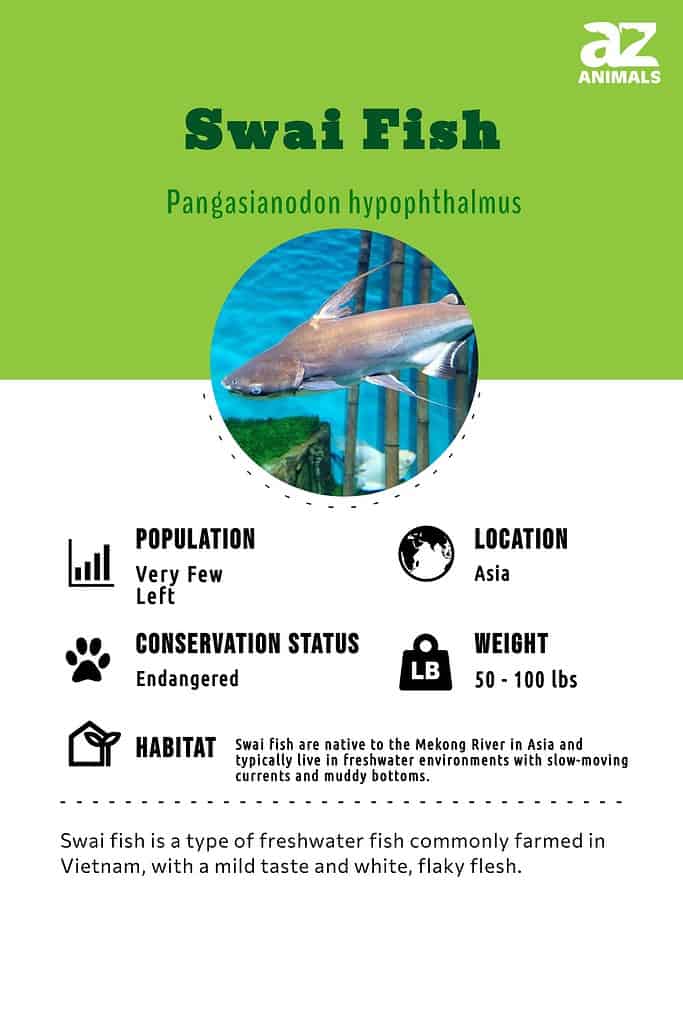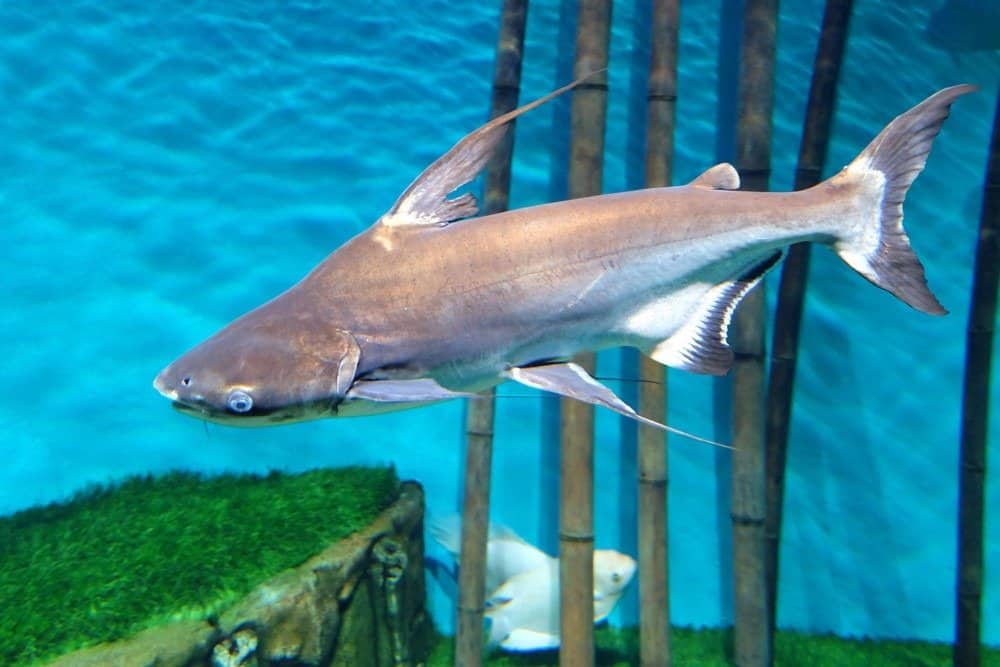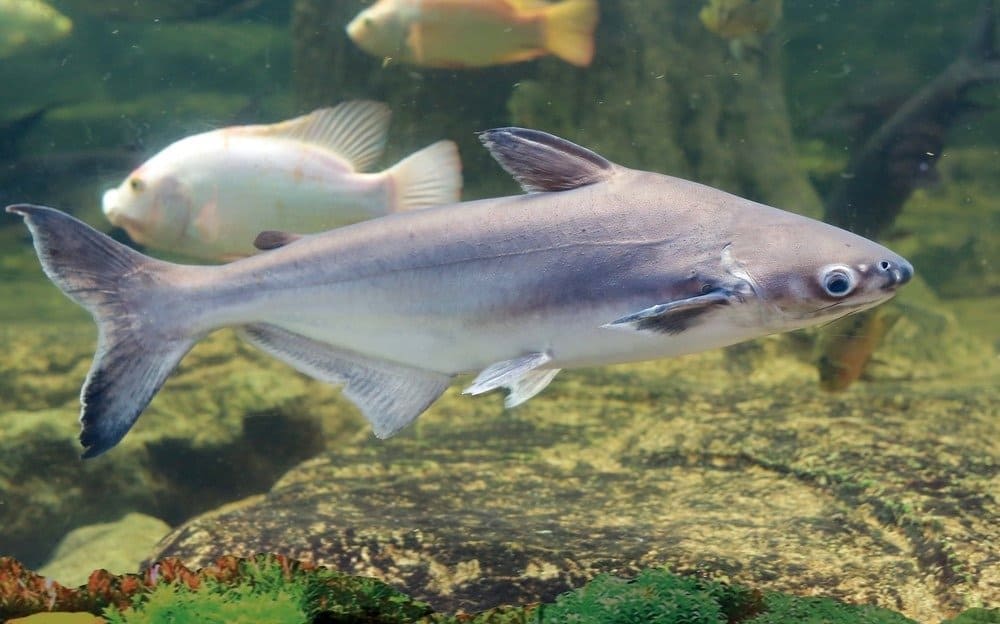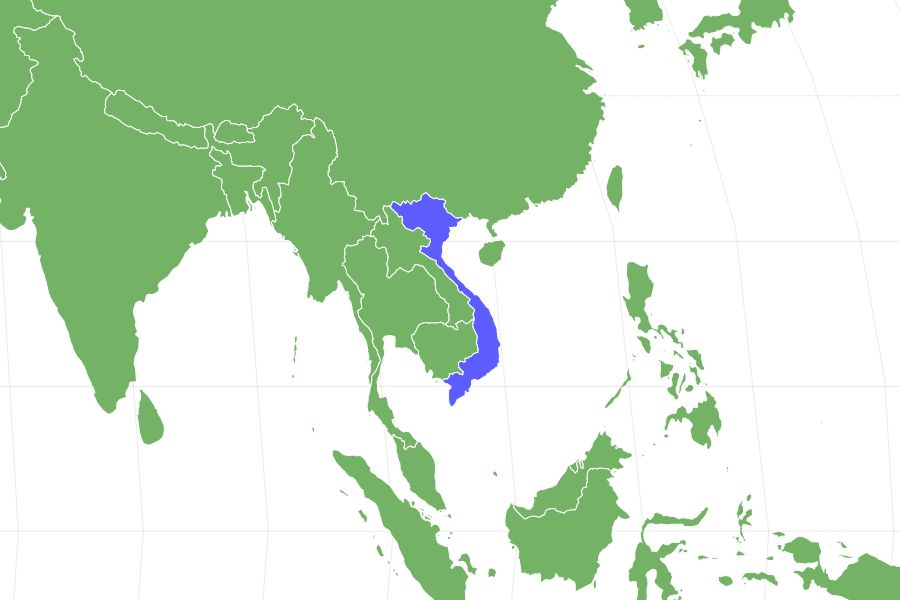Swai Fish
Pangasianodon hypophthalmus
The edges of an iridescent shark's fins have a signature glow
Advertisement
Swai Fish Scientific Classification
- Kingdom
- Animalia
- Phylum
- Chordata
- Class
- Actinopterygii
- Order
- Siluriformes
- Family
- Pangasiidae
- Genus
- Pangasianodon
- Scientific Name
- Pangasianodon hypophthalmus
Read our Complete Guide to Classification of Animals.
Swai Fish Conservation Status
Swai Fish Facts
- Prey
- Crustaceans, small fish, and plants
- Group Behavior
- School
- Fun Fact
- The edges of an iridescent shark's fins have a signature glow
- Biggest Threat
- Fishing
- Most Distinctive Feature
- Shark-style dorsal fin
- Other Name(s)
- Tra fish, iridescent shark, pangasius
View all of the Swai Fish images!

Swai fish, also known as iridescent sharks, is a type of shark catfish native to Vietnam.
These omnivorous bottom feeders live in the Mekong river and migrate upstream when the water levels rise in the late summer.
When left to their own devices, iridescent sharks can get as big as 100 pounds. Commercial farmers frequently breed large quantities of swai to sell as a popular replacement for catfish meat. You can also find small iridescent sharks that have been stunted in growth to serve as aquarium pets.
3 Incredible Swai Fish Facts!

The name “iridescent shark” refers to the shimmering sheen that can be seen even in the dark along the edges of the shark’s fins.
©Ollga P/Shutterstock.com
- Glowing fins: The iridescent shark’s name comes from the edges of its fins, which have a shimmery glow that is visible even in the dark.
- Endless appetite: Swai are known for eating nearly any kind of food they come across. Plants, crustaceans, and smaller fish are no match for the iridescent shark’s omnivorous appetite.
- Sharkfin style: Swai is a type of pangasius or shark catfish. Although they’re not actually sharks, these catfish all feature a dorsal fin and a silvery, shark-like appearance.
Classification and Scientific Name

The scientific name for swai fish is
Pangasianodon hypophthalmus
.
©CHAINFOTO24/Shutterstock.com
The scientific name for swai fish is Pangasianodon hypophthalmus. In Vietnam, they are often referred to as tra fish; they may also be mistaken for the related basa, or Pangasius bocourti. When they’re not being sold as livestock, these silver creatures are frequently called iridescent sharks for their glowing fins and shark-like appearance.
Iridescent sharks belong to the Actinopterygii class and Pangasiidae family of shark catfish. They are related to American catfish, but they are distinguished by their shark-like dorsal fins. In reference to their scientific name, shark catfish are also frequently called pangasius by members of the research community.
Evolution and Origins

The majority of the swai that can be purchased originates from fish farms in Vietnam, despite the fact that swai is originated from the Mekong River in Asia.
©GOLFX/Shutterstock.com
Swai is originally from the Mekong River in Asia, but most of the swai that people can buy comes from fish farms in Vietnam. Actually, Vietnam has one of the biggest industries for farming swai in the world, located in the Mekong Delta.
Swai fish and other fish imported from Vietnam are frequently regarded as “unclean” and generate a number of health issues due to their uneven quality. The majority of the swai fish (Basa) brought into the United States is native to Vietnam.
Furthermore, It may be recommended to stay away from Swai fish because of its subpar nutritional profile. It is imported from tightly populated fish farms where excessive amounts of pesticides and antibiotics are utilized, polluting the environment and endangering human health. Sometimes it is marketed under false pretenses as more expensive fish.
Different Types
Several names can be used to refer to swai fish, such as tra, striped Pangasius, Vietnamese catfish, striped catfish, iridescent shark, sutchi, and basa. There are only one sole species of this kind.
Appearance
Iridescent sharks are Asian catfish with silver scales, beige skin, and small whiskers. Like other shark catfish, pangasius has a small dorsal fin on the top of their bodies. The edges of a pangasius’ fins glow faintly underwater, making them a popular choice for aquariums.
Young iridescent sharks can grow to be anywhere from 1 to 4 feet long and typically weigh between 50 to 100 pounds. The largest ever recorded swai fish weigh 44 kilograms or about 97 pounds.
The growth of pangasius can be stunted by diet or a confined space, which is why iridescent sharks that live in aquariums are usually so much smaller than their wild or commercially-grown counterparts.

©CHAINFOTO24/Shutterstock.com
Distribution, Population, and Habitat
Iridescent sharks are native to Asia and are most commonly found within the country of Vietnam. Most wild pangasius lives in the Mekong river, where they swim upstream from the Maeklong basin. Some pangasius also swims downstream into the Chao Phraya.
Pangasius are freshwater fish and are popularly farmed in ponds, rice paddies, and similar structures. Nearly all commercially sold iridescent sharks are bred as livestock; you shouldn’t expect to purchase wild pangasius at a normal market.
Although population numbers are not available, iridescent sharks are considered to be endangered in their natural habitats.
Predators and Prey
Iridescent sharks are omnivorous animals that feed on crustaceans, algae, bugs, and other small fish. A swai will eat nearly anything it can catch as it grows to its full size of 100 pounds. When they are farmed commercially, pangasius is typically fed a diet that consists of barley, oats, and other types of grain.
Pangasius has no natural means of self-defense, making them a popular target for all predatory animals in their native region, including birds, mammals, and other large fish. Human fishermen are one of the primary threats to iridescent sharks, and overfishing is likely responsible for their current status of endangered.
Reproduction and Lifespan
Iridescent sharks are egg-laying creatures that live in large clusters. Like other types of catfish, pangasius breed in a migratory pattern that involves swimming upstream to a breeding ground during the late summer months.
Due to their wild nature, iridescent sharks are particularly difficult to breed in captivity. Pangasius farmers tend to keep the fish in large ponds with many other members of the same species to ensure adequate breeding conditions. Due to the lack of research on this particular type of fish, it is unknown how long a swai might live in the wild. In captivity, a well-loved iridescent shark might manage to have a lifespan as long as twenty years.
Fishing and Cooking
Although iridescent sharks are found naturally in the rivers of Vietnam, most commercial swai production takes place in controlled farming environments. Large groups of pangasius are kept in ponds, rice fields, and other watery areas until they are big enough to harvest for consumption.
In cooking, swai meat is used as a popular replacement for American catfish. The taste is described as sweet and significantly milder than their catfish cousins. Swai is known to have a tougher texture and slightly blander taste than basa, another shark catfish that is found in the same region.
Swai meat is a good source of nutrition with plenty of protein and vitamin B12. Unless you live in Vietnam, you are most likely to find pangasius meat in the frozen section, where it can stay fresh and delicious for up to a year at a time. Frozen pangasius meat can be baked, broiled, or fried to achieve the best taste. Just remember to thaw your frozen fish out before you cook it to prevent too much moisture from entering the dish.
View all 293 animals that start with SSwai Fish FAQs (Frequently Asked Questions)
Where is swai fish found?
Wild iridescent sharks are found throughout Asia, but they are considered native to the Mekong River in Vietnam. Commercial pangasius is typically kept in ponds and other types of local fish farms.
What is swai fish?
The iridescent shark is a type of catfish native to Vietnam. Swai meat is often sold as a popular replacement to American catfish or the slightly more expensive basa fish.
Is swai fish high in mercury?
Iridescent sharks have a relatively low mercury content. A study of commercially available pangasius only found a mercury content of 2 parts per billion.
Is swai fish banned?
As long as they are labeled correctly, iridescent sharks are not banned for sale or consumption anywhere in the first world. However, it is illegal to market pangasius as catfish in the United States.
Is swai fish safe to eat?
Swai meat is considered safe to eat and is a popular protein choice in many markets. However, be aware that any aquatic meat may be subject to questionable farming practices and should be purchased with consumer discretion.
Is swai fish healthy?
Swai meat is a relatively healthy protein choice for most diets. Pangasius meat contains high amounts of selenium, niacin, and vitamin B12.
Swai fish vs. Basa fish
Swai and basa are both types of shark catfish that are native to Vietnam. Basas, also known as Pangasius bocourti, are rarer than swai; they are also larger and typically have softer and more tender meat. Swai is often mislabeled as bocourti in some markets.
Are Swai Fish herbivores, carnivores, or omnivores?
Swai Fish are Omnivores, meaning they eat both plants and other animals.
What Kingdom do Swai Fish belong to?
Swai Fish belong to the Kingdom Animalia.
What phylum do Swai Fish belong to?
Swai Fish belong to phylum Chordata.
What class do Swai Fish belong to?
Swai Fish belong to the class Actinopterygii.
What family do Swai Fish belong to?
Swai Fish belong to the family Pangasiidae.
What order to Swai Fish belong to?
Swai Fish belong to order Siluriformes.
What type of covering do Swai Fish have?
Swai Fish are covered in Scales.
What is the scientific name for the Swai Fish?
The scientific name for the Swai Fish is Pangasianodon hypophthalmus.
How many species of Swai Fish are there?
There is 1 species of Swai Fish.
What is another name for the Swai Fish?
The Swai Fish is also called the tra fish, iridescent shark, or pangasius.
How do Swai Fish have babies?
Swai Fish lay eggs.
What's the difference between swai and catfish?
There are many differences between swai and catfish, including their sizes and locations. Swai are larger than some types of catfish and are only found in Asia, while catfish are found around the world.
What's the difference between Tilapia and swai fish?
There are many differences between swai fish and tilapia. Both are popular fish to cook, which brings about comparisons, but in the wild swai fish are significantly larger. In addition, Tilapia in the wild are found in Africa while Swai fish are found in Southeast Asia.
Thank you for reading! Have some feedback for us? Contact the AZ Animals editorial team.
Sources
- VASEP, Available here: http://mseafood.vasep.com.vn/panga/724_10857/what-are-biology-characteristics-of-tra-and-basa-fish.htm
- Seafood Handbook, Available here: https://www.seafoodsource.com/seafood-handbook/finfish/basaswai
- Fishbase, Available here: http://www.fishbase.us/summary/SpeciesSummary.php?ID=14154&AT=swai
- Fish Laboratory, Available here: https://www.fishlaboratory.com/fish/swai-fish
- National Library of Medicine, Available here: https://pubmed.ncbi.nlm.nih.gov/25198598/

















